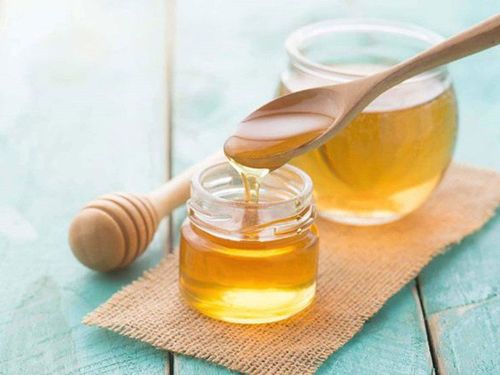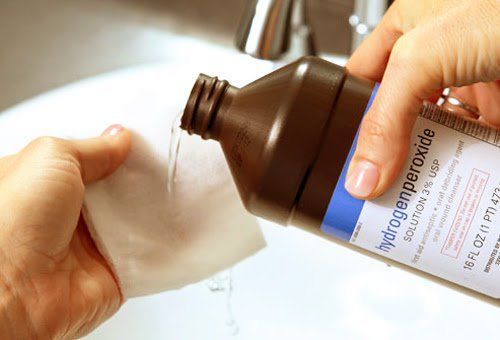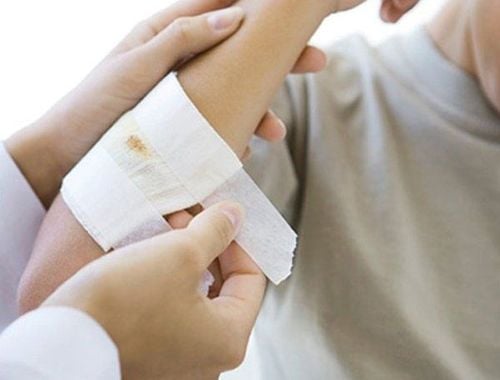This is an automatically translated article.
On the market today, there are many types of antiseptic solutions, including Keytadine. This is a commonly used antiseptic solution for external use, available at drugstores nationwide. Learn more about the uses of Keytadine to take it safely.
1. What is Keytadine?
The main ingredient in Keytadine is Povidon Iodine and excipients include:
Glycerol; Disodium hydrophosphate; citric acid; Sodium hydroxide; Distilled water. Keytadine is packaged in a green box or a rectangular yellow box.
2. Keytadine uses
What is Keytadine? This is an antiseptic containing Povidon - Iodine organic complex containing 5% oid-active iodine, which is released slowly because of its good antiseptic and fungicidal properties, so it is safe to use.
Keytadine solution is used for a long time in disinfecting and killing fungi, viruses, protozoa... Povidon is absorbed through the skin, excreted in the urine, absorption depends on the location and status of the drug. .
Indication of Keytadine in specific cases as follows:
Antiseptic of skin and mucous membranes before performing procedures, surgery, injection; Care for open wounds, burns...; Disinfect medical instruments before sterilization; Treatment of skin rash, diaper rash, finger and foot rash, foot water...; Keytadine is not used in the following cases:
Hypersensitivity to Iodine; Patients with thyroid disorders; Pregnancy, lactation, children under 6 months; Keytadine drug is not used for the above subjects.
3. Dosage – how to take Keytadine
Keytadine is used directly by applying, washing in combination with medical gauze, scissors, .. to disinfect the skin and mucous membranes. Apply medicine to cotton, clean gauze to disinfect on the skin before performing procedures, surgery or injection, intravenous infusion ...
Soak the medicine in cloth to cover burns, open wounds, incisions after surgery 1-2 times a day or dilute it at a ratio of 1/5 to wash wounds caused by burns, open wounds...
In cases where Keytadine is used to disinfect instruments, it is necessary to dilute the drug with clean water in proportion to 1/5 to soak the tool for about half an hour. Take out the instrument, wash it with clean water, dry it, and then disinfect it.
For patients with tinea capitis, foot water can be impregnated with Keytadine solution in a bandage and then applied to the affected skin area 1-2 times a day.
How to use Keytadine is quite simple, we can use it on our own or with medical assistance.
4. Keytadine drug effect
As a common antiseptic, but when using Keytadine we may also experience some side effects such as mild irritation. In some cases of systemic use on large wounds, severe burns can cause other systemic reactions
Although there are few side effects, when using Keytadine we also need to monitor and notify the patient. doctor for appropriate treatment.
5. Precautions while taking Keytadine
Although it is considered safe, when using Keytadine, caution must be exercised with the following groups:
Pregnant, breastfeeding; Limit use to large areas, repeated or long-term use; Use with caution in patients with renal failure, treated with lithium; To be on the safe side of medication, watch out for warnings from the manufacturer.
6. Keytadine drug interactions
Keytadine antiseptic can increase side effects, reduce effects when used with other ingredients, typically:
Used with alkaline and protein containing products; Interaction with mercury can cause skin corrosion; No longer effective when used with sodium thiosulfate, sunlight, high temperature, and other antiseptics; Keytadine interferes with thyroid function tests. It is important to inform your doctor/pharmacist when taking Keytadine with other antiseptic medicines.
Please dial HOTLINE for more information or register for an appointment HERE. Download MyVinmec app to make appointments faster and to manage your bookings easily.













